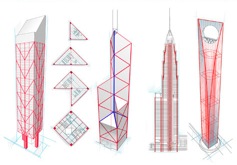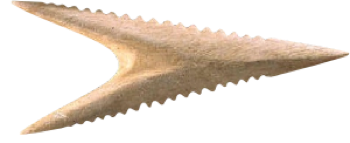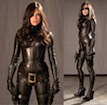Where could we use this material? In theory, assuming that it has a reasonable absolute strength, just about anywhere from skyscrapers and houses to toys and tools. And it could be very inexpensive to make, not counting design and other costs. (See also Configurations.)



Uses
Imagine a sofa that you could easily pick up with one hand and move to the other side of the family room.
If you had a Buckymesh car, what would the fuel efficiency be like?
If a 4 foot wide cable for the space elevator, which would be over 30,000 miles long, could have a mass less than 8 tons, which is about 4 ounces per mile (about 73 grams per kilometer) - would someone build one? (However, since this application only requires strength under tension, bundles of ropes of single-wall nanotubes may be stronger for the same mass.)
Consider a Boeing 747 that has a maximum takeoff weight of 975,000 lb. (442,250 kg), most of which is the plane and fuel. Imagine if the weight of the plane was much less than that of the passengers - how much fuel would you need then?
Consider the Golden Gate Bridge, which weighs almost a million tons. Imagine if you could build a bridge of the same length which weighed less than 1 ton - would it need to be the same shape?
The exact values shown here are to be taken with a large grain of salt i.e. they are rough.
For those who like answers to rhetorical questions, they are: very high, much less, no, and yes respectively. Yes who? NASA is who.
Since 100% of its atoms are on the surface, and it is made of carbon, Basic Buckymesh might be an excellent ultracapacitor (high-capacity electrolytic capacitor), possibly very suitable as a rechargeable battery for electrically powered vehicles.
In practice (initially), it will probably only be used where it makes a big difference, in such things as airplanes and spacecraft.
This material could also be used at smaller sizes, as scaffolding for other more complex structures at many scales, from nanometer upwards.
A few macroscopic examples might be useful here:
Considering just its weight: cover Fractal Buckymesh in something like a balloon and evacuate the air. It would then weigh about 10,000,000 times less than helium. Dirigibles anyone?
This material may also find applications because of its other properties not directly related to its high strength-to-weight ratio:
For the same reason, Basic Buckymesh might also be used as a fuel cell to store large amounts of hydrogen safely (just heat it to release the hydrogen, and cool it to store the hydrogen). One hydrogen atom could be stored for each carbon atom.
Basic Buckymesh would very likely have excellent projectile velocity reduction capabilities, being very light, highly performing body armor, bullet proof glass, and vehicular armor.










